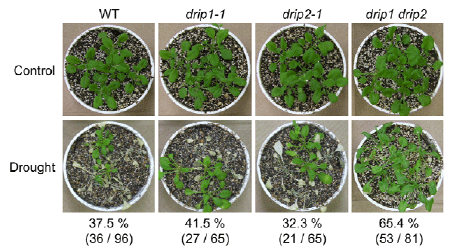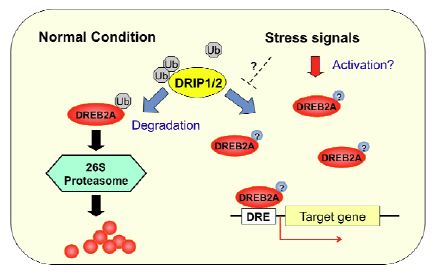Identification of two novel proteins which negatively regulate plant drought stress response
Description
Environmental stresses, such as drought, salinity and extreme temperatures, are major limiting factors which hinder crops from reaching their yield potential. In response to abiotic stresses, plants have evolved a number of mechanisms to achieve an optimal adaptation to the adversities. Dehydration-Responsive Element Binding protein 2A (DREB2A) is identified as an important transcription factor involved in plant drought and high temperature stress tolerance. DREB2A gene expression can be induced by drought, high salinity and high temperature stresses. As a transcriptional activator, it can activate a number of stress-responsive gene expressions upon receiving stress stimuli. It is proposed that DREB2A gene would be of great value to improve plant stress tolerance by means of biotechnology. However, recent research found that the ectopically expressed DREB2A protein is not stable in plants. Only if it is stabilized, can the DREB2A-CA (a Constitutive Active form) protein be stably accumulated in plant cells. Transgenic plants overexpressing the DREB2A-CA protein exhibit significantly enhanced tolerance to both drought and high temperature stresses. It is of great importance to understand how the DREB2A protein is regulated in plant cells, so as to have a better manipulation of this gene in plants.
In order to identify the DREB2A interacting proteins, we carried out yeast two-hybrid assay or screening. As a result, two proteins DRIP1 and DRIP2 (DREB2A Interacting Protein 1 and 2) were isolated. They share a conserved C3HC4 RING domain in the protein N-terminals and a high homology in the protein C-terminals. DRIP1 was found to interact with the DREB2A protein in the nuclei. An in vitro ubiquitination assay showed that they function as E3 ubiquitin ligases and mediate DREB2A ubiquitination. Overexpressing DRIP1 in Arabidopsis delayed the expression of DREB2A-regulated drought-responsive genes. On the contrary, the expression of many drought-inducible genes, such as RD29A, RD29B, LEA14, RD17, AtGolS1/2, was slightly enhanced in the single T-DNA mutants of drip1-1 and drip2-1. Significantly enhanced gene expression was revealed in the drip1 drip2 double mutant under dehydration stress. Moreover, the overproduced DREB2A protein was observed to be more stable in drip1-1 than in the wild-type background. Collectively, these results suggest that DRIP1 and DRIP2 are novel negative regulators in drought-responsive gene expression by targeting DREB2A toward 26S proteasome proteolysis.
Drought stress tolerance was also compared among the wild-type, drip1-1 drip2-1 and drip1 drip2 plants, according to their survival rate in the soil after they stopped receiving water. When data were analyzed from several independent tests, 37.5% of the wild-type plants survived from the drought stress treatment and 41.5% and 32.3% of drip1-1 or drip2-1 plants recovered from the stress after rewatering, respectively. The survival rate of the drip1drip2 double mutant was 65.4%, which is significantly higher than that of the wild-type plants. It implies that disruption of both the DRIP1 and DRIP2 genes might be helpful to exaggerate drought-inducible gene expression, thus enhancing plant stress tolerance. Coupled with the enhanced drought stress tolerance, a remarkably elongated period of plant growth was observed in drip1 drip2 double mutant plants, suggesting that DRIP1 and DRIP2 might also play a role in plant development.
Figure, table
-
Fig. 1. Enhanced drought stress tolerance of drip1 drip2 double mutant compared with the wild-type and single mutant plants.
Water was withheld from the soil-grown plants for two weeks. Survival rate was calculated one week after rewatering. -
Fig. 2. A model of DRIP1/2 functioning in dehydration stress signaling by targeting DREB2A degradation.
Under normal growth conditions, the ectopically expressed DREB2A protein is ubiquitinated and degraded by DRIP1 and DRIP2. Upon receiving stress stimuli, the protein degradation pathway is blocked and an activation modification might happen on DREB2A, so that plants are able to acquire a sufficient amount of effective DREB2A protein to activate downstream gene expression.
- Affiliation
-
Japan International Research Center for Agricultural Sciences Biological Resources Division
- Classification
-
Technical A
- Term of research
-
FY2008(FY2004~2011)
- Responsible researcher
-
QIN Feng ( Biological Resources Division )
MIZOI Junya ( Biological Resources Division )
YAMAGUCHI-SHINOZAKI Kazuko ( Biological Resources Division )
- ほか
- Publication, etc.
-
Qin, F., Sakuma, Y., Tran, L.-S. P., Maruyama, K., Kidokoro, S., Fujita, Y., Fujita, M., Umezawa, T., Sawano, Y., Miyazono, K., Tanokura, M., Shinozaki, K. and Yamaguchi-Shinozaki, K. (2008) Arabidopsis DREB2A-interacting proteins function as RING E3 ligases and negatively regulate plant drought stress-responsive gene expression. Plant Cell 20, 1693-1707.
- Japanese PDF


